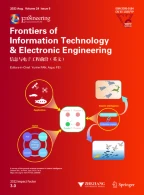Abstract
In this paper, three optimal linear formation control algorithms are proposed for first-order linear multiagent systems from a linear quadratic regulator (LQR) perspective with cost functions consisting of both interaction energy cost and individual energy cost, because both the collective object (such as formation or consensus) and the individual goal of each agent are very important for the overall system. First, we propose the optimal formation algorithm for first-order multi-agent systems without initial physical couplings. The optimal control parameter matrix of the algorithm is the solution to an algebraic Riccati equation (ARE). It is shown that the matrix is the sum of a Laplacian matrix and a positive definite diagonal matrix. Next, for physically interconnected multi-agent systems, the optimal formation algorithm is presented, and the corresponding parameter matrix is given from the solution to a group of quadratic equations with one unknown. Finally, if the communication topology between agents is fixed, the local feedback gain is obtained from the solution to a quadratic equation with one unknown. The equation is derived from the derivative of the cost function with respect to the local feedback gain. Numerical examples are provided to validate the effectiveness of the proposed approaches and to illustrate the geometrical performances of multi-agent systems.
Similar content being viewed by others
References
Alefeld, G., Schneider, N., 1982. On square roots of Mmatrices. Linear Algebra Appl., 42:119–119. http://dx.doi.org/10.1016/0024-3795(82)90143-4
Altafini, C., 2013. Consensus problems on networks with antagonistic interactions. IEEE Trans. Autom. Contr., 58(4):935–946. http://dx.doi.org/10.1109/TAC.2012.2224251
Anderson, B.D.O., Moore, J.B., 2007. Optimal Control: Linear Quadratic Methods. Dover Publications, USA.
Basiri, M., Bishop, A.N., Jensfelt, P., 2010. Distributed control of triangular formations with angle-only constraints. Syst. Contr. Lett., 59(2):147–154. http://dx.doi.org/10.1016/j.sysconle.2009.12.010
Bishop, A.N., 2011. A very relaxed control law for bearingonly triangular formation control. Proc. 18th IFAC World Congress, p.5991–5998.
Borrelli, F., Keviczky, T., 2008. Distributed LQR design for identical dynamically decoupled systems. IEEE Trans. Autom. Contr., 53(8):1901–1912. http://dx.doi.org/10.1109/TAC.2008.925826
Cao, Y., Ren, W., 2010. Optimal linear-consensus algorithms: an LQR perspective. IEEE Trans. Syst. Man Cybern. Part B, 40(3):819–830. http://dx.doi.org/10.1109/TSMCB.2009.2030495
Dimarogonas, D.V., Johansson, K.H., 2010. Stability analysis for multi-agent systems using the incidence matrix: quantized communication and formation control. Automatica, 46(4):695–700. http://dx.doi.org/10.1016/j.automatica.2010.01.012
Ghadami, R., Shafai, B., 2013. Decomposition-based distributed control for continuous-time multi-agent systems. IEEE Trans. Autom. Contr., 58(1):258–264. http://dx.doi.org/10.1109/TAC.2012.2204153
Ghadami, R., Shafai, B., 2014. Distributed observer-based LQR design for multi-agent systems. World Automation Congress, p.520–525. http://dx.doi.org/10.1109/WAC.2014.6936025
Godsil, C., Royle, G.F., 2013. Algebraic Graph Theory. Springer, USA.
Guo, J., Lin, Z., Cao, M., et al., 2010. Adaptive control schemes for mobile robot formations with triangularised structures. IET Contr. Theory Appl., 4(9):1817–1827. http://dx.doi.org/10.1049/iet-cta.2009.0513
Horn, R.A., Johnson, C.R., 1985. Matrix Analysis. Cambridge University Press, USA.
Horn, R.A., Johnson, C.R., 1991. Topics in Matrix Analysis. Cambridge University Press, USA.
Huang, H., Yu, C., Wu, Q., 2010. Distributed LQR design for multi-agent formations. Proc. 49th IEEE Conf. on Decision and Control, p.4535–4540. http://dx.doi.org/10.1109/CDC.2010.5716988
Li, Z., Duan, Z., Lewis, F.L., 2014. Distributed robust consensus control of multi-agent systems with heterogeneous matching uncertainties. Automatica, 50(3):883–889. http://dx.doi.org/10.1016/j.automatica.2013.12.008
Liu, T., Jiang, Z., 2014. Distributed nonlinear control of mobile autonomous multi-agents. Automatica, 50(4):1075–1086. http://dx.doi.org/10.1016/j.automatica.2014.02.023
Movric, K.H., Lewis, F.L., 2014. Cooperative optimal control for multi-agent systems on directed graph topologies. IEEE Trans. Autom. Contr., 59(3):769–774. http://dx.doi.org/10.1109/TAC.2013.2275670
Oh, K.K., Park, M.C., Ahn, H.S., 2015. A survey of multiagent formation control. Automatica., 53(3):424–440. http://dx.doi.org/10.1016/j.automatica.2014.10.022
Qin, J., Gao, H., 2012. A sufficient condition for convergence of sampled-data consensus for double-integrator dynamics with nonuniform and time-varying communication delays. IEEE Trans. Autom. Contr., 57(9):2417–2422. http://dx.doi.org/10.1109/TAC.2012.2188425
Qin, J., Gao, H., Zheng, W.X., 2011. Second-order consensus for multi-agent systems with switching topology and communication delay. Syst. Contr. Lett., 60(6):390–397. http://dx.doi.org/10.1016/j.sysconle.2011.03.004
Ren, W., Beard, R.W., Atkins, E.M., 2007. Information consensus in multivehicle cooperative control. IEEE Contr. Syst. Mag., 27(2):71–82. http://dx.doi.org/10.1109/MCS.2007.338264
Shi, G., Sou, K.C., Sandberg, H., et al., 2014. A graphtheoretic approach on optimizing informed-node selection in multi-agent tracking control. Phys. D, 267:104–104. http://dx.doi.org/10.1016/j.physd.2013.07.014
Xiao, F., Wang, L., Chen, J., et al., 2009. Finite-time formation control for multi-agent systems. Automatica, 45(11):2605–2611. http://dx.doi.org/10.1016/j.automatica.2009.07.012
Yu, C., Hendrickx, J.M., Fidan, B., et al., 2007. Three and higher dimensional autonomous formations: rigidity, persistence and structural persistence. Automatica, 43(3):387–402. http://dx.doi.org/10.1016/j.automatica.2006.08.025
Yu, C., Anderson, B.D.O., Dasgupta, S., et al., 2009. Control of minimally persistent formations in the plane. SIAM J. Contr. Optim., 48(1):206–233. http://dx.doi.org/10.1137/060678592
Zhang, H., Lewis, F.L., Das, A., 2011. Optimal design for synchronization of cooperative systems: state feedback, observer and output feedback. IEEE Trans. Autom. Contr., 56(8):1948–1952. http://dx.doi.org/10.1109/TAC.2011.2139510
Zhao, S., Lin, F., Peng, K., et al., 2014. Distributed control of angle-constrained cyclic formations using bearing-only measurements. Syst. Contr. Lett., 63:12–12. http://dx.doi.org/10.1016/j.sysconle.2013.10.003
Author information
Authors and Affiliations
Corresponding author
Additional information
Project supported by the National Natural Science Foundation of China (No. 61375072) (50%) and the Natural Science Foundation of Zhejiang Province, China (No. LQ16F030005) (50%)
ORCID: Yin-qiu WANG, http://orcid.org/0000-0002-1410-9619
Dr. Chang-bin YU, first author of this invited paper, received his Bachelor degree in Computer Engineering from Nanyang Technological Unviersity, Singapore, in 2004, and PhD degree in Engineering from the Australian National University, Australia, in 2008. Since then, he has been an academic staff with the Australian National University and subsequently held various appointments with Hangzhou Dianzi University (China), National ICT Australia (Australia), etc. His current research interests include control of autonomous formations, multiagent systems, mobile sensor networks, human-robot interation, and graph theory. He is Associate Editor of International Journal of Robust and Nonlinear Control.
Rights and permissions
About this article
Cite this article
Yu, Cb., Wang, Yq. & Shao, Jl. Optimization of formation for multi-agent systems based on LQR. Frontiers Inf Technol Electronic Eng 17, 96–109 (2016). https://doi.org/10.1631/FITEE.1500490
Received:
Accepted:
Published:
Issue Date:
DOI: https://doi.org/10.1631/FITEE.1500490
Keywords
- Linear quadratic regulator (LQR)
- Formation control
- Algebraic Riccati equation (ARE)
- Optimal control
- Multi-agent systems
